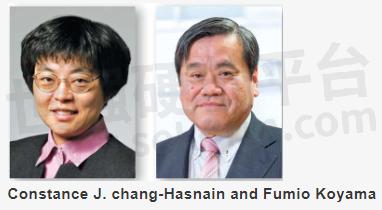Prof. Connie Jui-Hua Chang-Hasnain, the Chairperson of Berxel Photonics, Won the IEEE Medal of Honor in 2024

Connie Jui-Hua Chang-Hasnain and Fumio Koyama laid the foundation for VCSEL photonics, resulting in critical breakthroughs and opening doors to industrial applications that have had a significant impact on high-speed optical interconnects and optical sensing. With more than 2.1 billion devices deployed. VCSELs are by far the most pervasive type of laser today. Chang Hasnain and Koyama mostly conducted independent research but they collaborated and influenced each other's research They also worked closely to organize international education programs and conferences such as iNO. Their seminal work on the fundamentals and new functionalities of VCSELs created technology breakthroughs with lasting impact, Koyama realized the first room-temperature continuous wave (CW) operation of VCSELs in 1988, igniting research activities worldwide. Without his contributions, the realization of room temperature operation for VCSELs would have faced significant delays. Furthermore. his meticulous measurements of laser linewidth, intensity noise polarization control, and single-mode characteristics played a pivotal role in achieving CW operation. Simultaneously, Chang Hasnain provided invaluable theoretical guidance on the structure of transverse and longitudinal modes and demonstrated the first successful multimode fiber transmission. The combined efforts of Chang-Hasnain and Kovama established the foundational principles of VCSELs, Tunable VCSELs, particularly tunable micm-electromechanical systems (EMS) VCSELs, have opened up numerous applications, including micron-level depth measurement in swept-source optical coherence tomography with implications in ophthalmology, dermatology, cardiology, and gastroenterology, as well as in biomedical and pharmaceutical analysis. In 1995, Chang-Hasnain demonstrated the first widely tunable, swept MEMS VCSEL, and she also pioneered the development of HCG-based MEMS-VCSEL with the fastest swept speed, In addition, Chang-Hasnain realized the first VCSEL arrays at 940nm for 3D imaging in 1998, which are now deployed in smartphones worldwide for facial recognition applications. Multi-Mode Fiber (MMF) MM-VCSEL transmission has now been widely adopted in data centers and supercomputers. In short, VCSELs play a critically important role in many applications, including optical communications, sensing systems, biophotonics, medical imaging, consumer electronics, and LIDAR with a projected market value of over $10 billion. The field of VCSELs owes much of its vibrancy to the groundbreaking work of Chang-Hasnain and Kovama.
An IEEE Fellow, Chang-Hasnain is the Whinnery Chair Professor Emerita, University of California Berkeley, Berkeley, California. The USA.
An lEEE Life Fellow, Koyama is a Professor Emeritus, the Tokyo Institute of technology, Yokohama, Japan.

For pioneering contributions to vertical-cavity surface-emitting laser (VCSEL) and VCSEL-based photonics for optical communications and sensing
- +1 Like
- Add to Favorites
Recommend
- Coherent Reports Significant Advancement in VCSEL Performance for Next-gen AI Networks
- UU Winding Common Mode Choke Commonly Used in Switching Power Supply: Xiangru Electronic XRUU9.8-10mH-V, Vertical Plug-in Design, Low Loss
- Coherent Introduced 100G PAM4 VCSEL and Photodiode Arrays for 800G Transceivers and Active Optical Cables
- II-VI Incorporated Announced AEC-Q102 Compliance of its 940 nm VCSEL Flood Illuminator Modules for Automotive In-Cabin Applications
- Coherent Unveils Patented Module Architecture for UltraCompact Dynamic Illumination and Sensing with Backside-Emitting VCSEL ARRAYS
- Coherent High-Power Diode Laser System, Bringing Laser Cladding to Indonesia
- KYOCERA to Acquire 100% Ownership of California-Based SLD Laser
- Coherent Laser FrameWork Makes a Mark in Siemen’s Digital Factory
This document is provided by Sekorm Platform for VIP exclusive service. The copyright is owned by Sekorm. Without authorization, any medias, websites or individual are not allowed to reprint. When authorizing the reprint, the link of www.sekorm.com must be indicated.





























































































































































































































































































































































































































































































































































































































































































































































































































































































